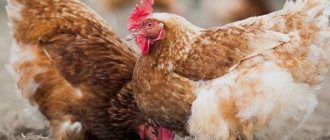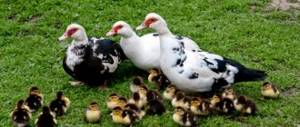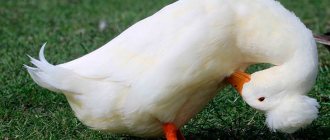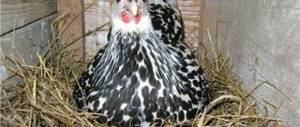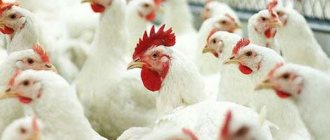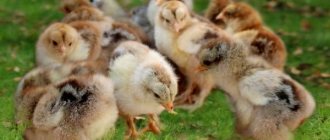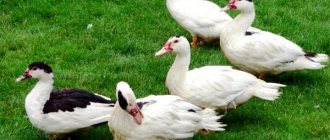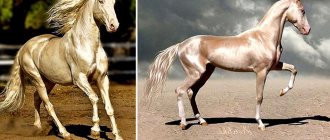When choosing a chicken breed, poultry farmers pay more attention to productivity. However, when this indicator is also supported by decorativeness, the birds become favorites of the yard. Vocal singing roosters have been famous since ancient times. Their crowing is most often heard at dawn. Old people in villages determine the dawn of a new day by singing. One of these singers is the Yurlovskaya vociferous bird; the main characteristics and features of the singing breed of chickens are worth considering in detail.
Origin story
According to assumptions, the breed was bred about 200 years ago in the village of Yurlovo, which was located in the Oryol region. This settlement has not survived to this day. Judging by the external characteristics of the bird, ordinary backyard laying hens, Chinese chickens and fighting roosters were taken for crossing.
The Yurlovsky vocal breed of chickens was formed on the principle that mature roosters have a sonorous melodic voice.
In the 19th century there was a popularity for cock singing competitions. They were arranged by chicken owners right at the market. The owner of the rooster who is able to last his song for more than 18 quarters wins. It is assumed that the Yurlov breed was bred precisely for these competitions.
Maintenance and care
Although representatives of this breed are distinguished by their unpretentiousness and high immunity, they are still quite demanding regarding the air temperature in the poultry house. The temperature there should be regularly maintained at about 12 degrees Celsius or higher. And the duration of daylight in the chicken coop should be about 13 hours.
For one individual of the Yurlovsky vocal breed, there should be about half a meter of space in the house.
The flooring must be sufficiently thick and permanent. The best materials for such a covering are peat, straw or sawdust. Such materials absorb moisture well. Typically, such flooring is replaced every six months.
Perches and nests should be placed at a height of 1 m. The nests should be lined with bran and straw.
It is also necessary to provide these active birds with a walk with a high fence around it.
Feeding these chickens is no different from feeding chickens of other breeds. Representatives of this breed are prone to obesity, so the amount of food that the birds eat at one time is poured into the feeders.
Description of appearance
In the Yurlov breed, males are particularly decorative. Roosters have a strong build, an upright body, and strong legs. The breed is recognized by the following characteristics:
- The body is slightly elongated, the body is always level. The bird stands steadily on strong legs.
- The wings are medium in size; the bird usually presses them tightly to the body.
- The head on the long neck seems huge, but the beak is small.
- The large frontal bone with the special shape of the eyebrow frame creates the effect of a menacing facial expression.
- The comb is bright pink, the earlobes are red.
The exact shade of the eyes depends on the color of the plumage, and there is a wide variety of colors. Most often the birds are black with a silver back. Gold flecks may be present. There are birds of white and silver color. The plumage of any color in chickens is not dense. If you pull it apart, the skin is clearly visible. The tail is bushy and long, especially in roosters.
Important! Birds of the Yurlov breed are frequent guests of exhibitions, but to participate, the chicken must be purebred.
Appearance
Description of the breed. Feathered, vocal chickens have an awkward appearance, but from the outside they look majestic. Distinctive features of Yurlov birds:
- To understand the size of individuals, it is worth talking about live weight data at maturity. The male weighs up to 6.5 kilograms, the female – up to 4 kilograms.
- The body is elongated upward, the shape is rectangular with a horizontal position - these are signs of the fighting blood of the ancestors. The silhouette of the Yurlovskaya chicken has strict features - the tail and neck are at an angle of 90 degrees to the body. The sternum is rounded, not narrow, developed. The back is round. The average size of the wing tightly pressed to the body.
- Birds look tall, this is due to their long lower limbs and neck. Roosters are slightly taller than hens. The color of the paws is yellow or orange. The thighs and lower legs are more developed in males, while in females they are lush.
- The head size is large, wide in shape. A red face with earrings and a comb of the same color. The earrings are small and round. Comb in the shape of a leaf, rose or nut. The emphasis of the face is on the arches near the eyebrows and the strong short beak. The beak is colored black, yellow, and silver.
- There are several types of coloring of Yurlov birds. The most common ones are silver, black or Colombian.
Character of chickens
If you want to have a Yurlov breed, you will have to come to terms with the complex character of the bird. Roosters are real fighters, they are capable of starting a showdown out of nowhere. Females have their own special temperament. They do not accept newcomers into the family and conflict with other birds living in the yard.
Important! Chickens solve all problems that arise in the herd only through a fight.
Due to its complex nature, it is important to form a flock correctly, leaving 1 rooster for 8 females. Otherwise, fights will result in injured individuals, and some of them may die. Vocal singing is inherent in every rooster. The ringing voice of the male can be clearly heard within a radius of 20 m. Every morning, singing will replace the alarm clock, since it begins at the same time.
Temperament
The character of the Yurlovsky vociferous is an interesting topic. Everyone knows that the nuances of care and maintenance are closely related to the nature of the chicken coop. Those who prefer to listen to the vocals of roosters will have a hard time - the singers have a complex character.
Chickens and roosters love to show their character and solve all problems with physical force
Therefore, it is important to approach the topic of family distribution delicately so that there are no problems or squabbles in the yard
Singing talent carries with it a special feature. Chickens can't help but sing. The farmer does not have to use alarm clocks so as not to forget to give out feed in the chicken coop - not only the inhabitants of the yard, but also the neighbors wake up from the loud voice of the rooster.
Many farmers soundproof their chicken coops so they don't have to worry about singing or disturbing their neighbors.
Productivity Description
In terms of ripening, the bird is late, because this is exactly what its creators sought. Thanks to such indicators, males develop a better voice and talent. Late maturation is also influenced by heavy weight. Chickens take a long time to develop muscle mass; they become mature at 8-9 months.
See also: How to make chicken nests with your own hands?
An amazing breed of chickens, the Yurlovsky Vociferous, is popular not only among professional poultry farmers, but also among amateurs.
Roosters grow to weigh up to 6-7 kg, chickens are usually 2 kg lighter. The breed cannot boast of high egg production, but laying hens lay large eggs weighing from 70 g. In a year, a chicken can lay up to 160 eggs.
There is an instinct for incubation, but it is peculiar. The laying hen sits on the eggs without any problems whenever she wants and gets up and leaves at any time. In theory, this behavior is not inherent in chickens that are not hybrids or purebred representatives. However, in reviews, bird owners describe such observations. The hen will have to be constantly monitored, and it is better to send the eggs directly to the incubator.
Productive qualities
Considering that the Yurlovskaya breed is of a mixed breed, that is, meat and egg, the egg production rate of 140-170 eggs annually is not so bad. Although there are varieties of universal type chickens that produce more egg products. The shell color is white or light cream. The weight is quite large - up to 70 grams. However, there are individuals that delight their owners with giant testicles, the mass of which is 95 grams.
Fertility occurs in more than 90% of eggs laid. It cannot be said that Yurlov laying hens do not have a brooding instinct at all. This needs to be clarified experimentally. Some chickens sit on a clutch of eggs without any problems and hatch them until the chicks hatch.
Birds of this breed quickly gain body weight and are profitable to breed for meat production. A chicken carcass weighs on average up to 3.5 kg, and a rooster weighs 4-5.5 kg. Excellent performance for universal type domestic birds.
Contents of Yurlovsky vocal chickens
Continuing the review of the main characteristics and features of the singing breed of Yurlovskaya vociferous chickens, it is worth paying attention to the issue of living conditions. The bird is large in size; in the chicken coop, 1 m2 of free space is allocated for 2 birds. The temperature is constantly maintained from 10 to 20°C. In winter, turn on red lamps or electric heaters. Daylight hours for laying hens are extended to 12-14 hours with artificial lighting. Supply and exhaust ventilation with adjustable dampers must be installed.
Among meat and egg breeds, Yurlov chickens are of average popularity.
It's all about character traits and the consumption of a large amount of food. Birds need a spacious run, they attach it from a mesh to the barn on the side of the manhole. The height of the fence should be at least 2 m, otherwise chickens will easily overcome it. In the enclosure, as well as inside the chicken coop, feeders, drinking bowls, and baths with sand and ash are installed.
For laying hens, nests are placed in a secluded corner of the chicken coop at a height of 50 cm from the floor. 1 piece is enough for 3-4 chickens. The perches are raised up to 80 cm from the floor, and each bird is given a minimum of 35 cm of perch length. In winter, the floor is covered with a 5 cm thick bedding made of sawdust, straw, and peat. After it gets dirty and wet, it is changed.
Features of care and feeding
High egg production is achieved through proper nutrition:
- After hatching and drying the fluff, the chickens are fed 6-8 times a day with boiled chopped eggs. On the 3rd day, they begin to mix cereal porridge and low-fat cottage cheese. From 2 to 6 months, active growth of the young occurs. In addition to food for weight gain, chickens are given vitamins. The younger generation is completely transferred to complex store-bought feed, and the frequency of feeding is reduced to 3 times a day. The diet includes vegetables, root vegetables, and herbs.
- Adult chickens are given whole grain cereals or ground grain mixtures. Males eat up to 150 g of food per day, and females - 100 g. In winter, chickens are fed wet mash with the addition of grass meal once a week. Vegetables and root crops are given at 100 g per head. Laying hens are fed protein-rich feed; maggots, fermented milk products, and fish can be given.
Chickens love warmth.
It is important to monitor the temperature; it ranges from 25 to 30 degrees. In summer, for young animals and adults, daytime feeding is replaced by grazing outside.
One of the main characteristics and features of the singing breed of chickens, Yurlovskaya Vociferous, is considered to be high feed consumption. Because of this deficiency, birds are not in demand by farmers engaged in industrial breeding.
